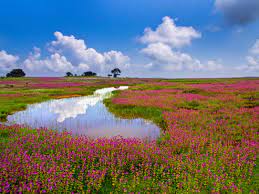Kaas Plateau : Climate And Environmental Changes

A recent study by the Agharkar Research Institute (ARI), Pune along with the National Centre for Earth Sciences, Thiruvananthapuram decoded climate and environmental changes on Kaas Plateau.
Key findings:
- Sediment profile dating back to 8000 years which helped decode climatic signatures indicated a relatively reduced rainfall and weak southwest monsoon during the late Holocene (around 2827 years BP).
- The seasonal lake in the Kaas Plateau is probably a product of an erosional localized shallow depression on a pediment (rock debris) developed over the crust.
- During the early to mid-Holocene, at around 8664 years ago, pollen, as well as diatom data, indicated a change in the climate from freshwater to drier conditions with low rainfall.
- Surprisingly, there was a significant rise in the number of diatoms in between.
- This suggests a major shift in the Indian summer Monsoon activity during that time, possibly resulting in intermittent humid periods amidst the dry spells.
- There was a decrease in rainfall and a weakened southwest Monsoon during the late Holocene (around 2827 years BP).
- During the recent past (around last 1000 years), pollen, as well as the presence of a high number of planktonic and pollution-tolerant diatom taxa indicated lake eutrophication, possibly due to human impact and cattle/livestock farming in the catchment.
Kaas Plateau:
- It is nestled in the Western Ghats is about 140 km from Pune.
- It is part of the Western Ghats which was declared as world natural heritage site by United Nations Educational, Scientific and Cultural Organisation (UNESCO) in 2012
- It is known as Kaas Pathar in Marathi, its name is derived from the Kaasa tree, botanically known as Elaeocarpus glandulosus (rudraksha family).




